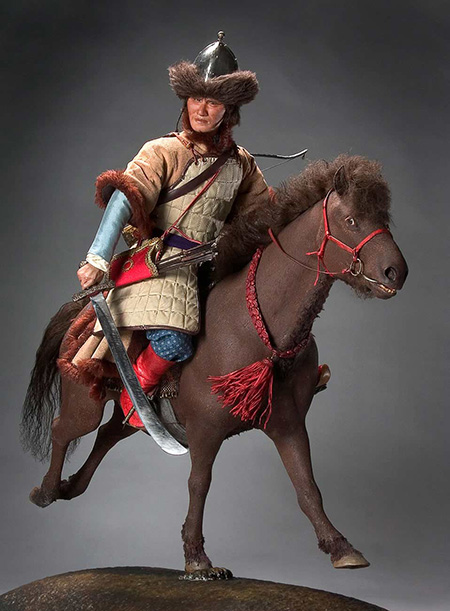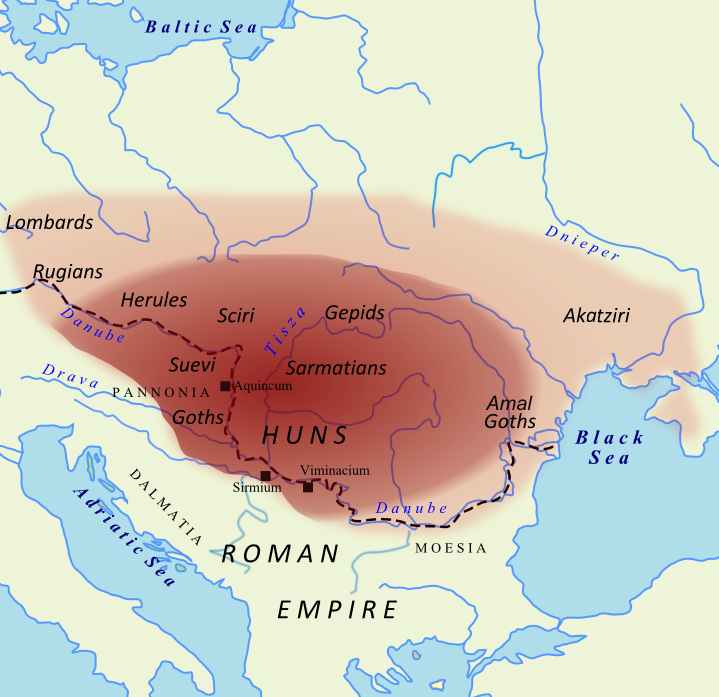The Huns were an Asian tribe of Turco-Mongol descent. They were nomads who were skilled horsemen and archers; they advanced through the so called “gateway of nations”, from the steppes of middle Asia to the plains of southern Russia. They formed a tribal alliance which was composed of various people that lived in the Lower Volga, Don and Northern Caucasus region. The neighboring tribal alliance were the Goths, who were settling the Lower Dnieper region under their king Ermanaric. The Goths were defeated by the Huns in 375, and Ermanaric committed suicide.
The other barbaric nations were fleeing from the Huns, thus pressuring the borders of the Roman Empire. Due to these events there were many interconnected migrations that came in waves in Europe, and they are known as the “Great migrations”, which, in a strict sense, lasted until the second half of the 6th century.
The Huns reached Pannonia by the end of the 4th century. Their alliance, which stretched from the Volga in the east to Pannonia in the west, was composed by the tribes of the Antes, Khazars, Gepids, Heruli, Suebi, Quadi, Ostrogoths and Scirii.
Attila (434 – 453)
The Hun tribal alliance was ruled by two brothers who succeeded in 434: one of them was Attila, who spent his youth in Roman captivity, while the other one was named Bleda. Attila murdered his brother in 445, and remained the sole ruler over a vast territory. He reached Jutland in the north, and the Thermopylae pass (Greece) in the south during his destructive campaigns. He was residing in his capital during the rare moments when he was not waging war from his saddle. His capital was in the vicinity of the town Tokaj, north on the Tisza River.



Attila’s court was visited by an eastern Roman delegation in the fifth century. The delegation was led by the learned Roman diplomat Priscus. Priscus would later write a book about the Hun court and their way of life, but sadly, the work was lost. Some fragments were preserved, they give us valuable insights. According to Priscus, Attila surrounded himself with a retinue that was composed by the chieftains of the subjugated nations. The court ceremonial was Gothic, and the court was secured by guard towers and strong-points. The Huns only engaged in animal farming, the subjugated people were covering any other needs.
Constant raids and conquests led to material differentiation. The tribal and official aristocracy owned slaves, and the most powerful were masters over villages that were completely subjected to them. The Huns collected high tributes from the eastern Roman emperors until the rule of emperor Marcian (450 – 457). Upon his ascension to the throne Marcian refused any further payments. He said that he has grapes for the Hun king, but no gold. Attila turned to the western part of the empire to compensate for the losses. They already nicknamed him Flagellum Dei at that time, which means, “The scourge of God”. They believed that he was sent by God himself to punish them for their sins.
The western Roman empire was ruled by emperor Valentinian III (425 – 455). Honoria, the sister of the emperor, sent her signet ring to Attila, as a plea for help, after her refusal to marry a local aristocrat. Attila saw this as an marriage offer and demanded the hand of his sister from Valentinian and a half of the empire as dowry. Since Valentinian refused, Attila decided on invading Gaul. The decisive battle was led on the Catalaunian plains in 451, northwest of Paris on the Marne River. The Roman army was led by Aetius. It was reinforced by Frankish, Burgundian and Visigoth forces. The Hun forces were led by Attila himself. There was no definitive winner, but Attila left Gaul with the loot that he gained.



In 452 Attila advanced into the Padus valley, and raided Aquileia and Mediolanum. He was discouraged in his planned advance on Rome by pope Leo the first (440 – 446), who threatened him with an anathema (according to church records); or he was payed of with vast riches. Whatever the case, Attila retreated into Pannonia.
Attila died in 453 after a feast during his marriage ceremony. It is not clear if his death was natural. He was buried in three caskets: one was made a gold, another one of silver and the third was made of iron. He is still known in many nations because of his fame, for example: in Hungary he is known as Etzel, or as Atila Pooglavog among the southern Slavs. The Hun tribal alliance disintegrated after the death of Attila. It is true that the Huns are mentioned throughout the fifth century, but they never formed another strong state. They retreated into the south Russian steppes and integrated with the local nations.
